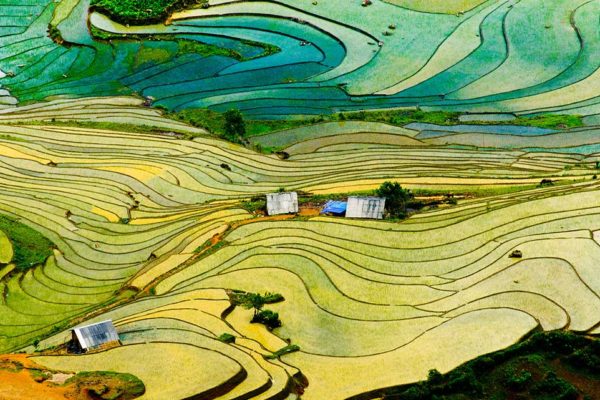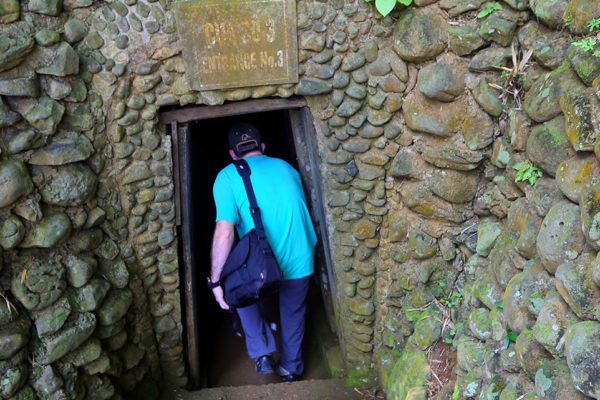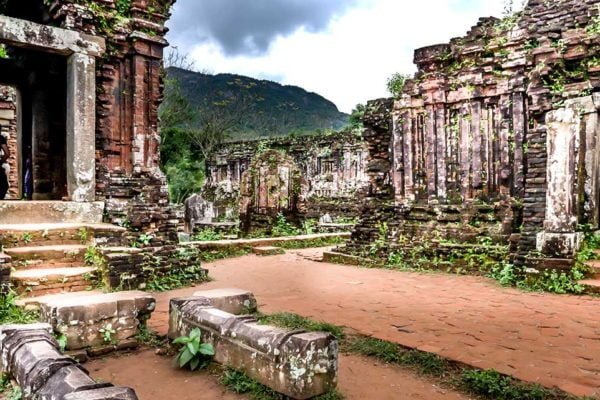Kayak in Vietnam: Discover the Most Beautiful Spots and Essential Tips
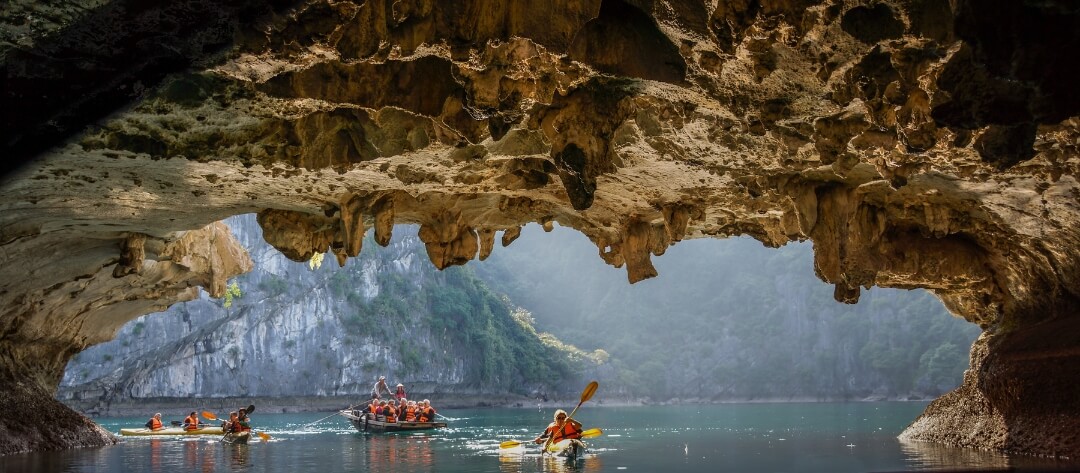
Few experiences capture Vietnam’s beauty quite like gliding across its waters, where limestone cliffs rise dramatically and quiet rivers reveal daily life along the banks. From emerald bays dotted with hidden caves to tranquil mountain lakes, kayaking opens a doorway to both nature and culture. With its accessibility, affordability, and sense of adventure, kayaking in Vietnam has become a must-try activity for travelers of all ages.
This guide highlights the most breathtaking spots and essential tips to kayak in Vietnam, helping you plan the perfect journey across the country’s diverse waterways.
Why Kayaking in Vietnam Will Amaze You
Vietnam is a kingdom of water, where every river, bay, and lake invites travelers to step closer. Kayaking here is not a simple outdoor activity; it is a journey into beauty, serenity, culture, and discovery.
Breathtaking Natural Beauty
Stepping into a kayak in Vietnam feels like entering a living watercolor painting. Every paddle stroke reveals a different hue—emerald waters glistening under the sun, limestone towers carved by centuries, jungles spilling down into hidden rivers. When National Geographic ranked Halong Bay among the world’s premier kayaking destinations, it was recognition of a natural wonder where thousands of karst pillars rise from quiet seas.
Serenity and Connection
Drift across Ba Be Lake, where ancient forests guard the mirror-like surface, or slide silently through Lang Co Bay, where sky and water blur into a horizon of tranquility. In these places, kayaking becomes more than recreation—it becomes meditation. The steady rhythm of your paddle echoes like a heartbeat against silence, grounding you in the present while offering an escape from the noise of daily life.
Cultural Immersion
Kayaking also reveals Vietnam’s cultural heartbeat. Glide past floating villages in Halong Bay, where fishermen mend nets with deliberate precision, or venture into the Mekong Delta to encounter bustling floating markets alive with chatter and color. On the water, culture doesn’t feel staged; it surrounds you in its most authentic form, raw and unfiltered.
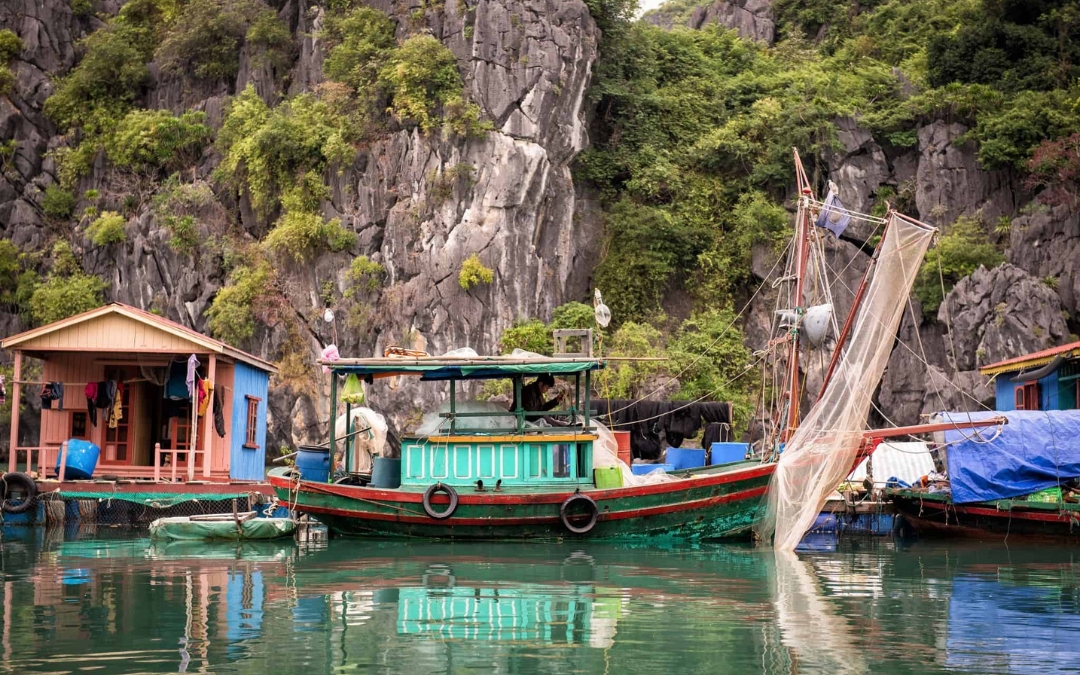
Underground wonders await those who drift into hidden caves.
Adventure, Accessibility, and Accomplishment
Unlike extreme sports demanding years of training, kayaking in Vietnam invites everyone—families, couples, even children alongside parents.
Calm bays welcome beginners, while caves and rock arches challenge adventurers. Night paddles in Phong Nha add an otherworldly touch, sometimes with bioluminescence glowing against the oar. Affordable rentals and guided tours make it widely accessible, and with every journey comes not only discovery but also the deep sense of accomplishment that stays long after you return to shore.
Top Places to Kayak Across Vietnam
Vietnam is home to some of the best places to kayak, featuring emerald bays, hidden caves, and quiet riverside villages.
Northern Vietnam – Bays, Lakes, and Rivers of Contrast
Halong Bay (Quang Ninh Province)
A UNESCO World Heritage Site and “undisputed champion” of kayaking, Halong Bay is globally recognized as one of the top 25 premier kayaking destinations by National Geographic. Thousands of limestone pillars rise from emerald waters, creating endless routes through caves, lagoons, and hidden inlets. Highlights include Luon Cave, home to golden monkeys; Trinh Nu Cave with its legendary stalactites; and Vung Vieng Village, where floating houses reveal traditional fishing life.
Calm waves make the bay ideal for beginners, with Halong kayak rentals from 40,000–50,000 VND or included in overnight cruise packages. The best time is March–June or October–December, while summer storms from July–September should be avoided.
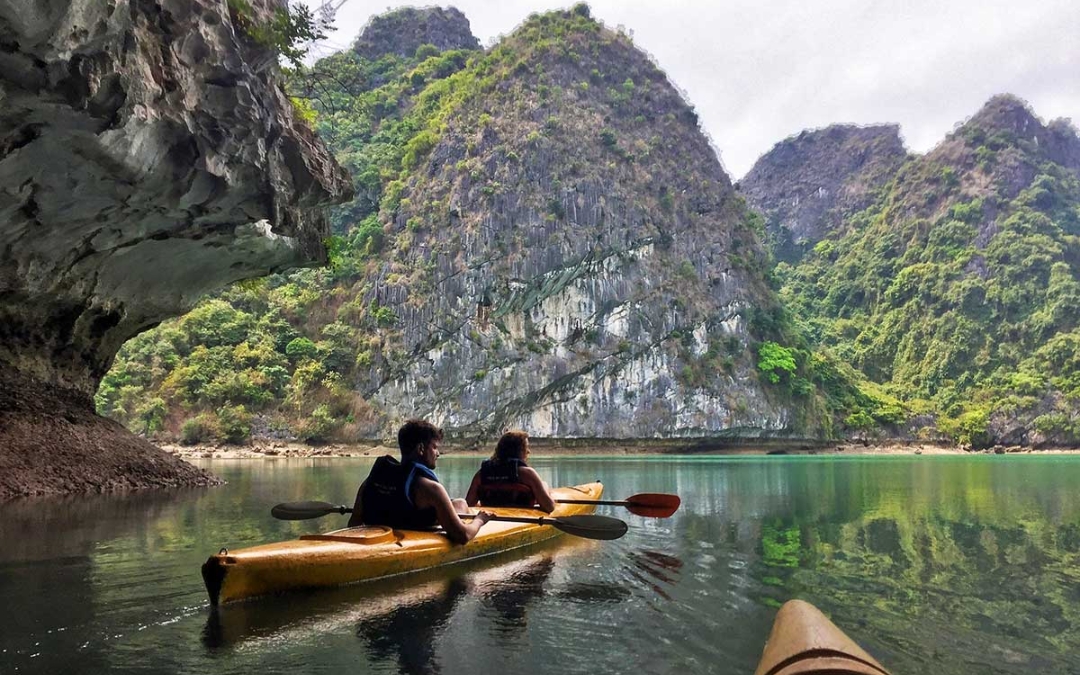
Halong Bay’s emerald waters invite kayakers to glide beneath cliffs.
Lan Ha Bay & Cat Ba Island (Hai Phong Province)
Adjacent to Halong Bay but far less crowded, Lan Ha Bay offers more than 300 karst islands and secluded beaches that create a serene paddling environment. Ao Ech Lagoon and Van Boi Beach are standout spots, while the Dark & Light Cave marks the natural border with Halong.
Cat Ba Island serves as a perfect base, allowing travelers to combine kayaking with trekking and cycling in Cat Ba National Park. Like Halong, Lan Ha Bay is beginner-friendly, with numerous rental shops and tour operators based on the island. Spring and autumn provide the clearest skies and most enjoyable waters.
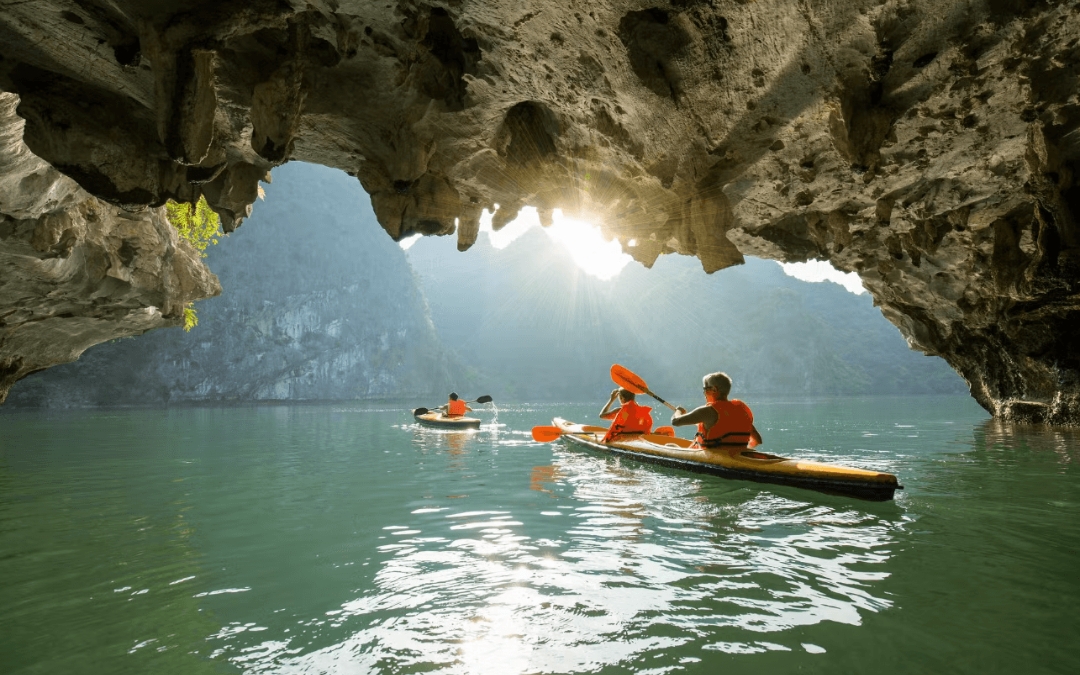
At Lan Ha Bay, visitors paddle past floating villages and quiet caves.
Ba Be Lake (Bac Kan Province)
Hidden within Ba Be National Park, Ba Be Lake is Vietnam’s largest natural freshwater lake and an oasis of calm. Surrounded by limestone mountains and dense jungle, it offers a tranquil escape from busy tourist hubs.
Popular routes include paddling toward Puong Cave, a massive cavern carved into the cliffs, and visiting Tay ethnic minority villages along the shore. The lake remains best during the dry season from October to April, when the water is at its clearest.
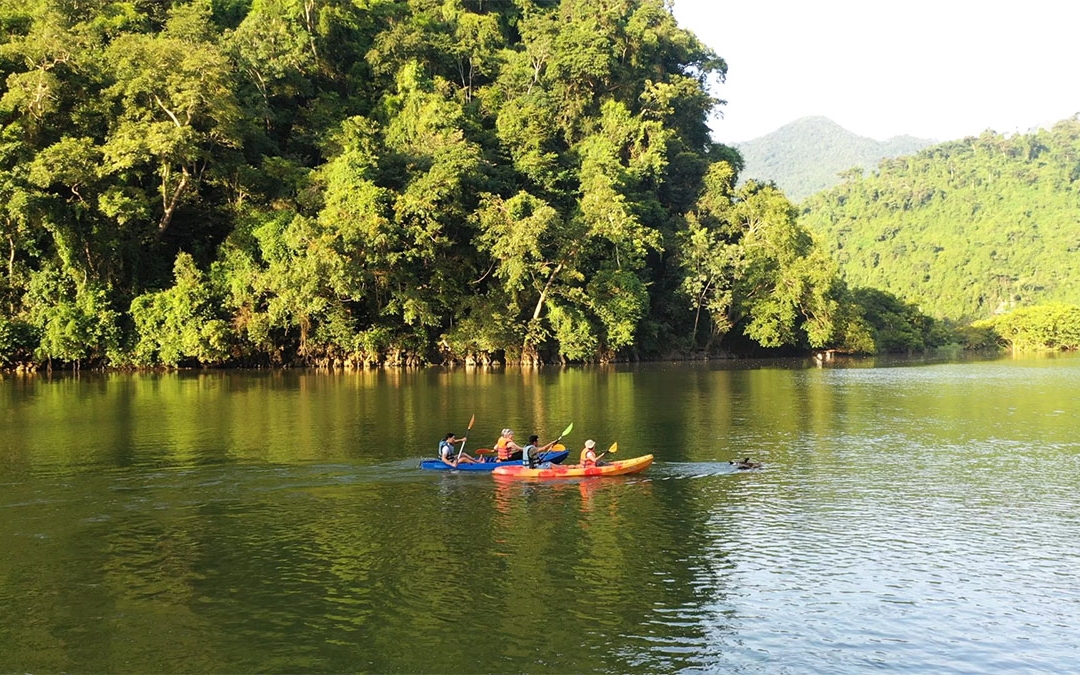
Ba Be Lake rewards explorers with tranquil scenery and pure air.
Bai Tu Long Bay (Quang Ninh Province)
Bai Tu Long Bay is often described as Halong’s quieter cousin, with the same limestone karsts but fewer boats. It is ideal for those craving solitude and pristine scenery. Kayakers can explore Thien Canh Son Cave, paddle across hidden lagoons, or stop at Vung Vieng fishing village for cultural immersion.
The bay retains much of its untouched ecosystem, making each journey feel like venturing into uncharted territory. Kayaking is available through local tours and cruises, typically at similar rates to Halong Bay. The best months are March–May and September–November, with pleasant weather and calm waters.
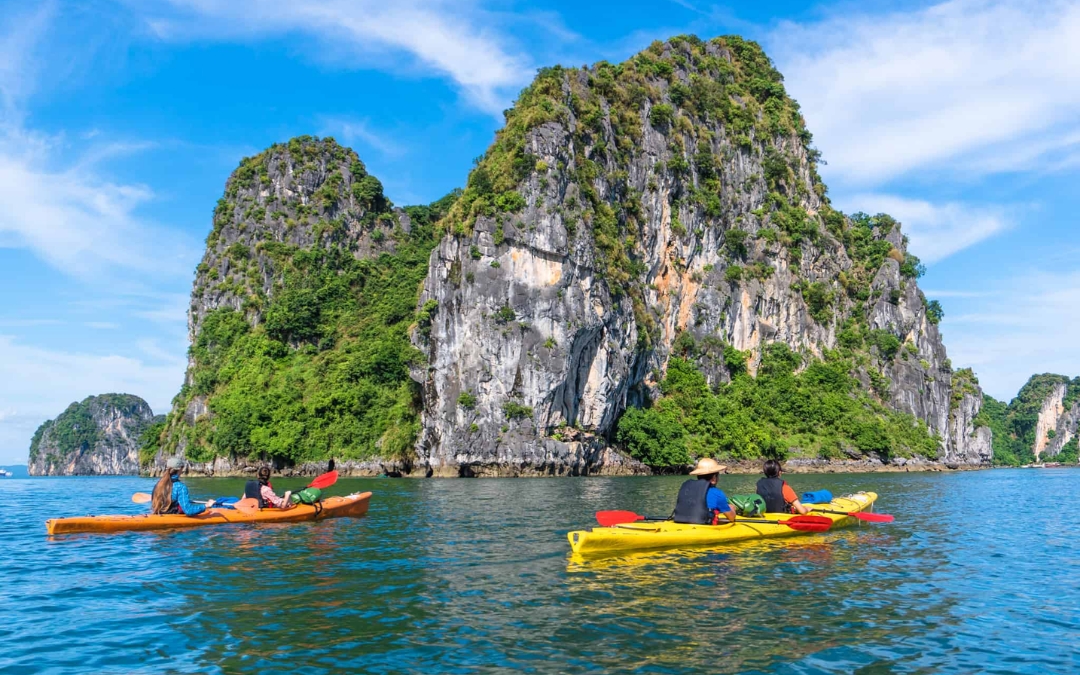
Bai Tu Long Bay offers untouched beauty away from crowded routes.
Ha Giang – Nho Que River & Tu San Gorge
Though Ha Giang is better known for mountains, its kayaking scene is a hidden treasure. The Nho Que River runs jade-green through Tu San Gorge, the deepest canyon in Southeast Asia. Paddling here feels otherworldly, with towering cliffs on both sides and almost no tourist traffic.
Most visitors rent kayaks near Ma Pi Leng Pass, though off-the-beaten-path spots near Khau Vai or Du Gia also offer peaceful waters. The dry season from October to April is best for river clarity and safe navigation.
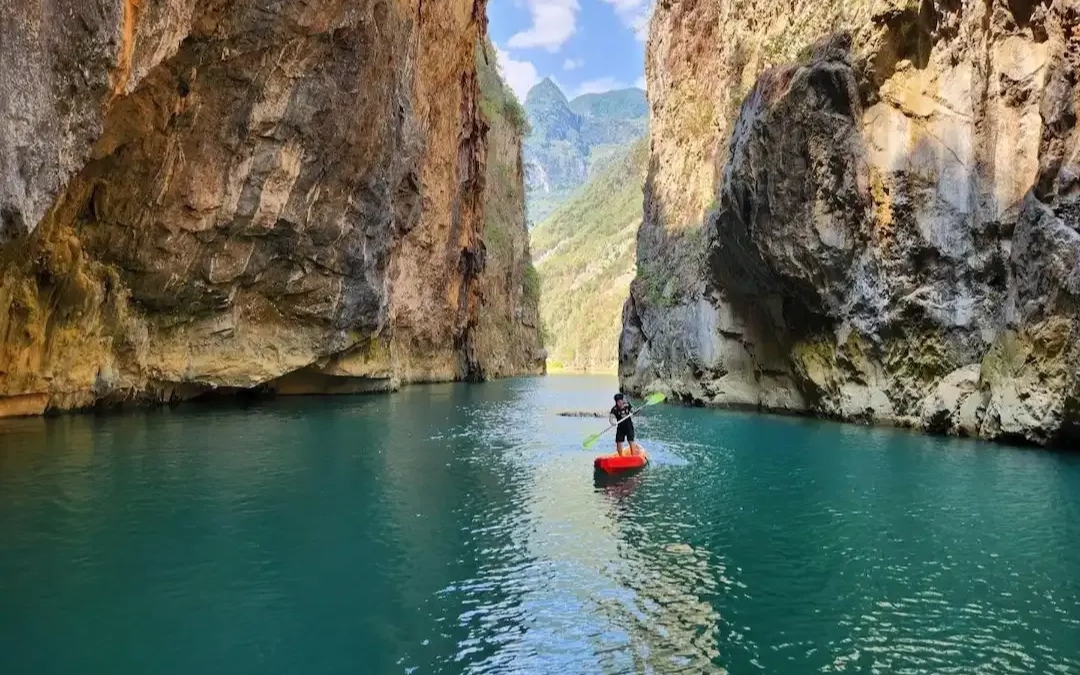
The Nho Que River winds through Tu San Gorge in Ha Giang.
>> See Tour: Best Ha Giang Loop Tour
Ninh Binh – Trang An & Cuc Phuong
Known as “Halong Bay on land,” Ninh Binh enchants with rice fields, limestone peaks, and waterways winding through caves and temples. Ninh Binh kayaking in Trang An lets visitors explore Dark and Bright Caves, glide past Trinh Temple, or admire misty landscapes at sunrise.
Nearby Cuc Phuong National Park offers calm lakes for paddling amid rainforest and wildlife. Tours here are highly beginner-friendly, often guided, making it simple for families or first-timers. The most atmospheric time is early morning, when light mist lingers and crowds are minimal.
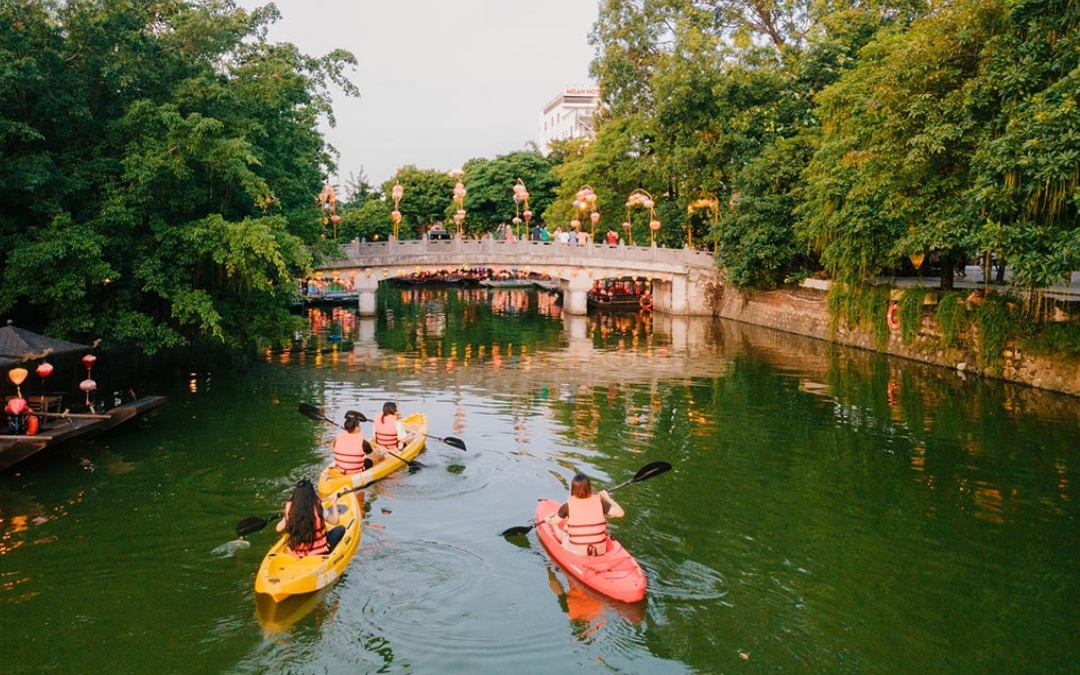
In Trang An, paddlers drift past limestone caves and sacred temples.
>> See Tour: Hanoi – Sapa – Ninh Binh – Halong Bay Trip
West Lake – Hanoi
For travelers without time to leave the city, Hanoi kayaking on West Lake provides a convenient introduction to the sport. The vast urban lake offers views of the capital’s skyline, traditional temples, and leafy boulevards.
While it lacks the dramatic limestone scenery of other destinations, it delivers a distinct cultural perspective—especially at sunset, when the city glows and the lake’s surface reflects its shifting colors.
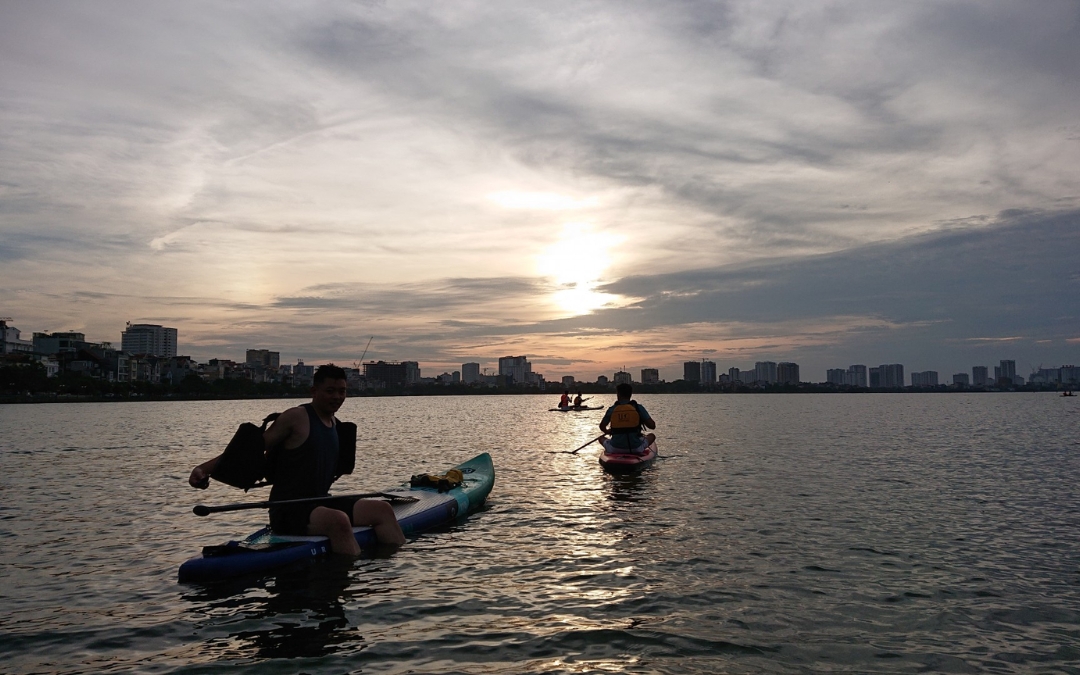
Locals in Hanoi enjoy peaceful evenings kayaking on West Lake.
>> See Tour: Splendours of Vietnam Beach Tour
Central Vietnam – Rivers, Lagoons, and Hidden Caves
Central Vietnam offers a different kayaking mood compared to the dramatic north. Here, emerald rivers carve through jungles, lagoons shimmer at sunset, and coastal towns blend culture with calm waterways. It is a region where kayaking easily mixes with heritage, adventure, and daily local life.
Phong Nha – Ke Bang National Park (Quang Binh Province)
Renowned for its vast cave systems, Phong Nha–Ke Bang is an adventure paradise for kayakers. The Son River winds through lush valleys, while paddling directly inside Phong Nha Cave reveals colossal chambers of stalactites. Night kayaking here is unforgettable, sometimes lit by bioluminescence in the dark waters.
The Chay River–Dark Cave route adds more thrill with ziplining, mud baths, and limestone passages. Kayak rentals cost about 100,000 VND ($3.6) per hour for two people. The dry months from March to August are ideal for exploring.
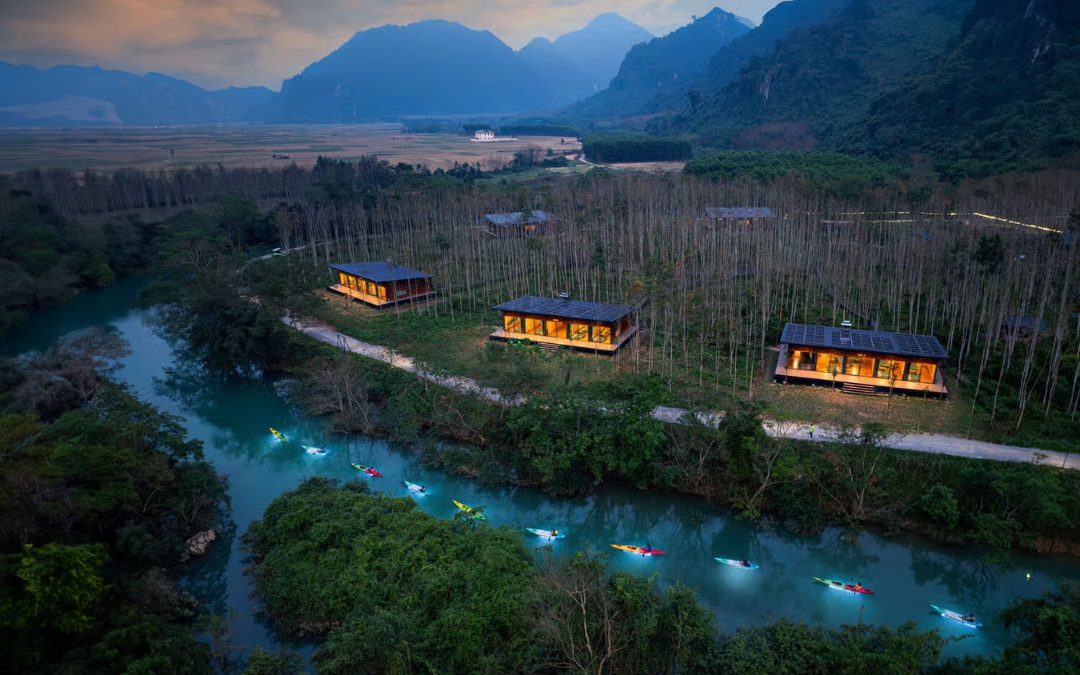
Explore Phong Nha in the late afternoon.
Hoi An – Thu Bon River & Coconut Forest (Quang Nam Province)
The charming town of Hoi An is renowned not only for its lanterns and architecture but also for its Hoi An kayaking experiences on the Thu Bon River. Paddling here brings views of rice paddies, fishing boats, and peaceful countryside.
A highlight is the Bay Mau Coconut Forest, where green nipa palms create natural tunnels for kayaks to drift through. Some routes even reach the Old Town or Cua Dai Estuary, combining culture with nature. Early mornings bring calm waters and soft sunrise light, making this a serene and photogenic trip.
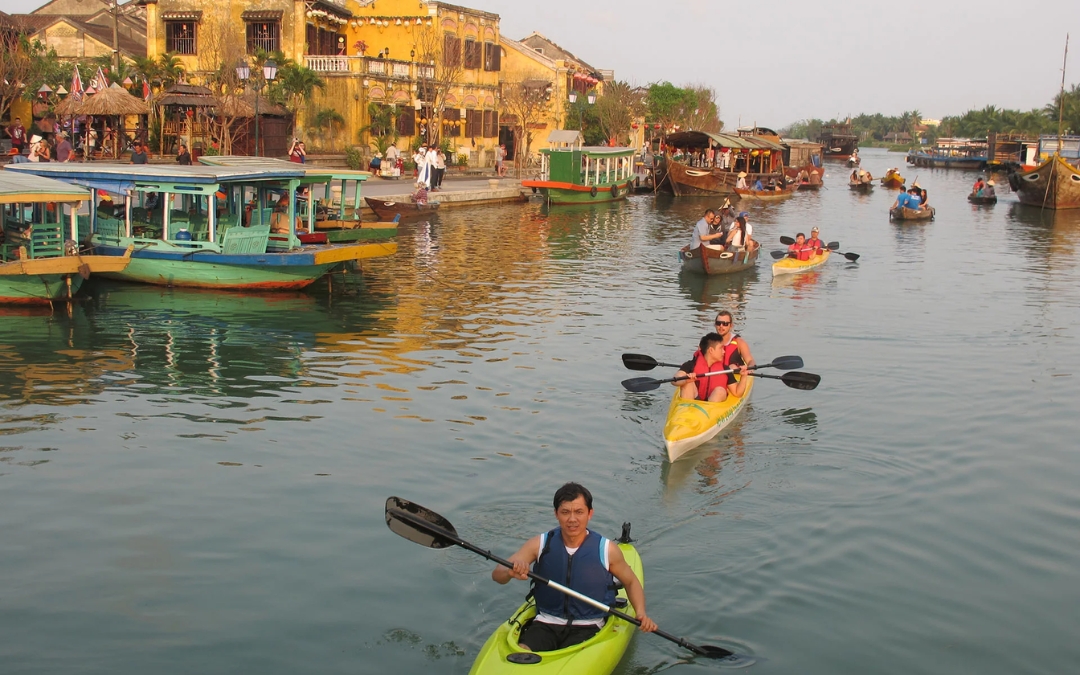
Thu Bon River in Hoi An reveals coconut forests and golden sunsets.
Hue – Chuon Lagoon, Lang Co Bay & Perfume River
Romantic Hue offers multiple waterways perfect for Hue kayaking. Chuon Lagoon is known for its shallow, mirror-like surface, where fishermen’s huts and traps form an atmospheric backdrop, especially at sunset.
Lang Co Bay, at the foot of Hai Van Pass, feels like a hidden paradise, with calm dawn or dusk paddles framed by mountain silhouettes. On the Perfume River, travelers experience Hue’s poetic charm, passing temples and riverside villages. Many local tours combine kayaking with seafood meals at floating huts. The best time is April–September for clear skies and warm weather.
Da Nang – Han River
Modern yet poetic, Da Nang offers unique kayaking opportunities on the Han River. The popular route runs from Dragon Bridge to Han Bridge, letting paddlers see the city’s vibrant life from the water.
Sunset is particularly stunning as the skyline glows and bridges light up. Rentals cost around 100,000 VND (about $3.6) per person. The experience stands out for combining outdoor fun with the energy of one of Vietnam’s fastest-growing cities.
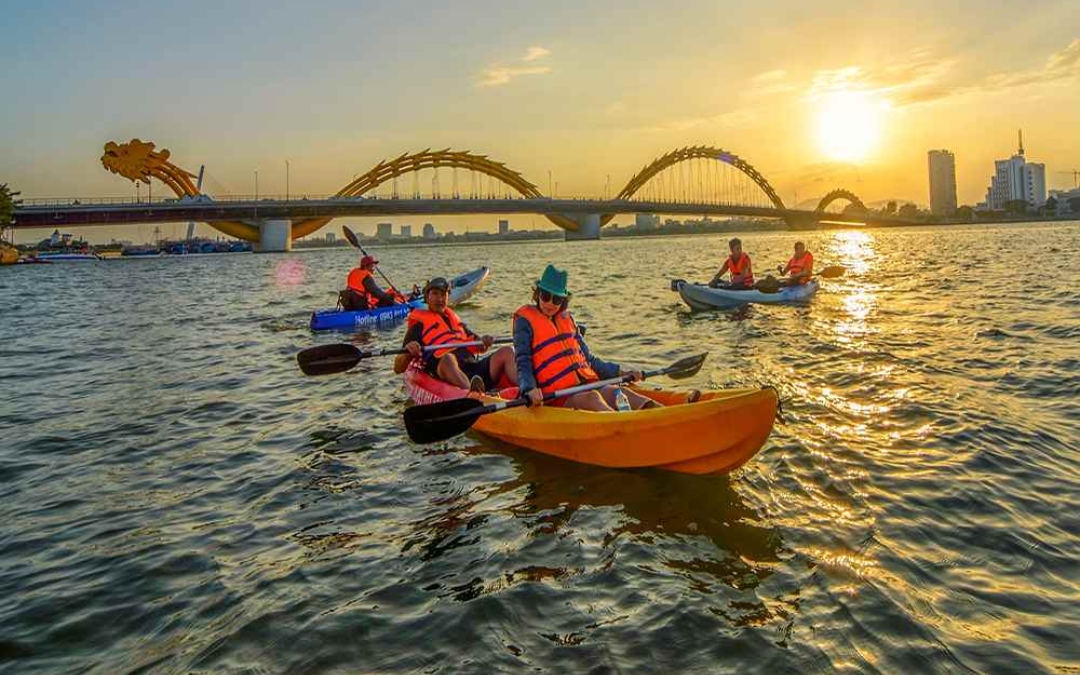
The Han River lights up Da Nang with vibrant urban kayaking.
Nha Trang – Coastal Bays & Islands (Khanh Hoa Province)
Famous for its long coastline and offshore islands, Nha Trang islands create a paradise for sea paddlers. Nha Trang kayaking tours often circle small islands like Hon Mun or Hon Tre, where clear waters reveal coral reefs beneath. Paddlers can explore hidden coves, sandy beaches, and fishing villages that still preserve traditional life.
Rentals and tours are widely available, with half-day trips averaging 150,000–250,000 VND per person. The best season is January–August, when the seas are calm and the skies are bright.
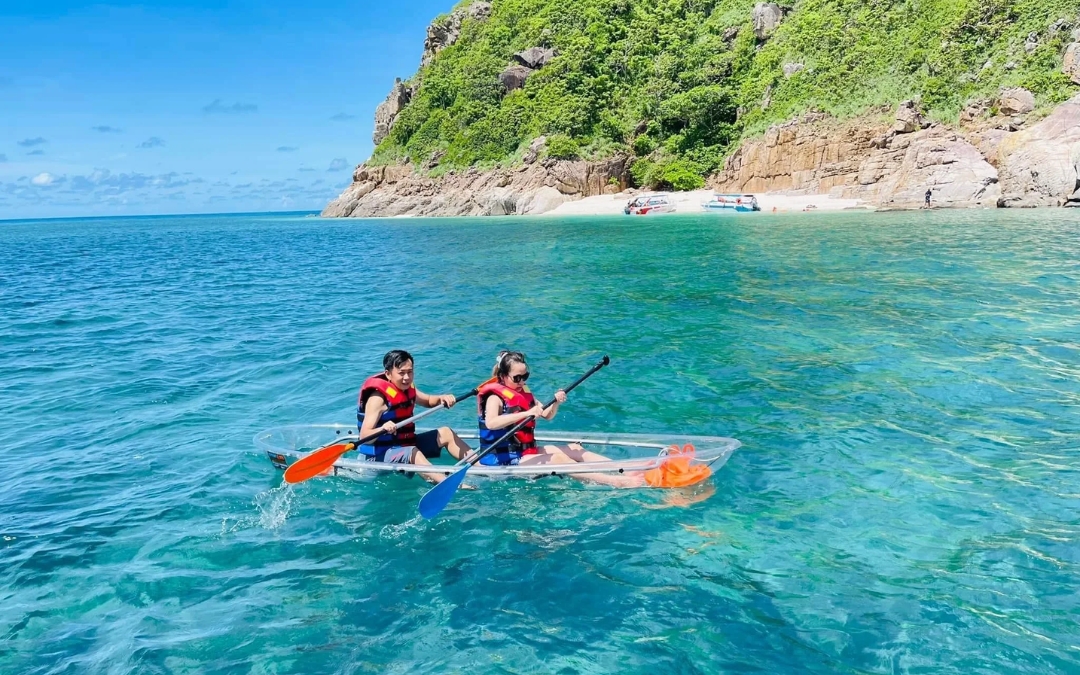
Nha Trang’s bays welcome paddlers to turquoise waters and islands.
Southern Vietnam – Rivers, Islands, and Tropical Waters
The south of Vietnam brings another rhythm to kayaking: wide river deltas rich with culture, tranquil lakes hidden in pine forests, and turquoise seas surrounding tropical islands. Unlike the north and central regions, Southern Vietnam emphasizes daily life on water and warm, year-round paddling conditions.
Mekong Delta – Can Tho & Tram Chim National Park
The Mekong is a labyrinth of rivers and canals, perfect for kayaking. From Can Tho, travelers can paddle at dawn to witness floating markets like Cai Rang, where vendors sell fruits and goods directly from boats.
Tram Chim National Park in Dong Thap offers a completely different experience—paddling through flooded melaleuca forests while spotting rare birds such as the Sarus crane. The calm waters make this region highly beginner-friendly, and tours often include fruit tastings or cultural stops.
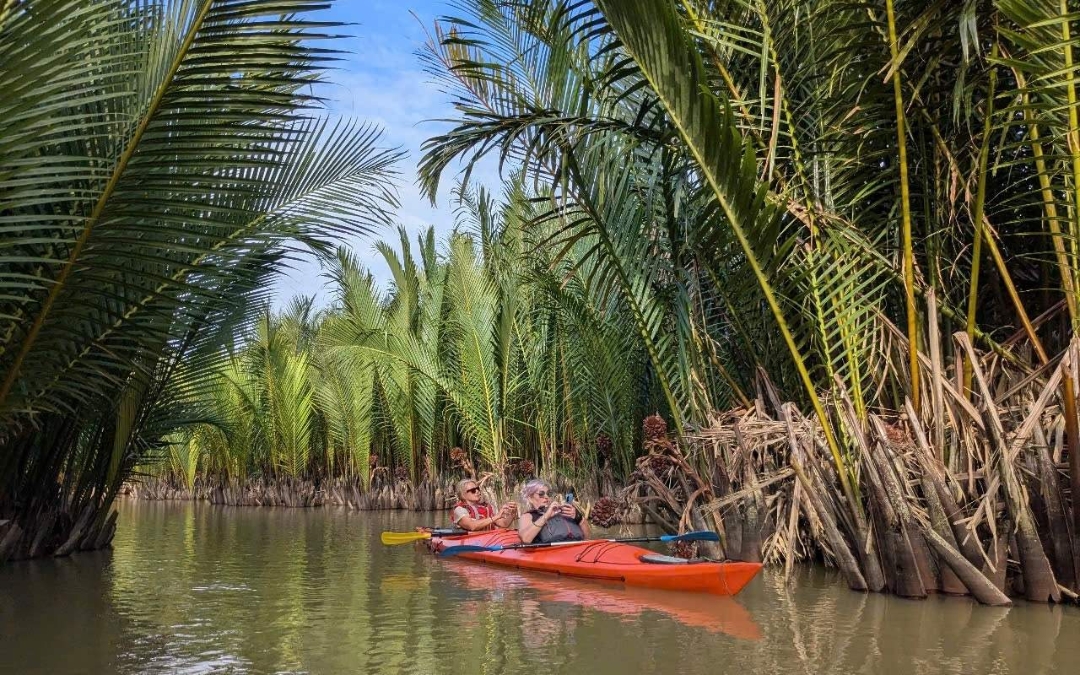
The Mekong Delta lets kayakers witness water coconut and storks.
>> Read More: What To See In Mekong Delta Of Vietnam: Uncover The Hidden Charms
Phu Quoc Island (Kien Giang Province)
Vietnam’s largest island offers both sea and river adventures for Phu Quoc kayaking. Sao Beach is ideal for gliding across calm, turquoise waters, while the Cua Can River winds through rainforest and fishing hamlets, giving a glimpse of local life.
Kayaks can be rented directly on beaches or through eco-tours, often combined with snorkeling or fishing activities. Sun protection is essential here, as the tropical sun can be intense even in the early hours.
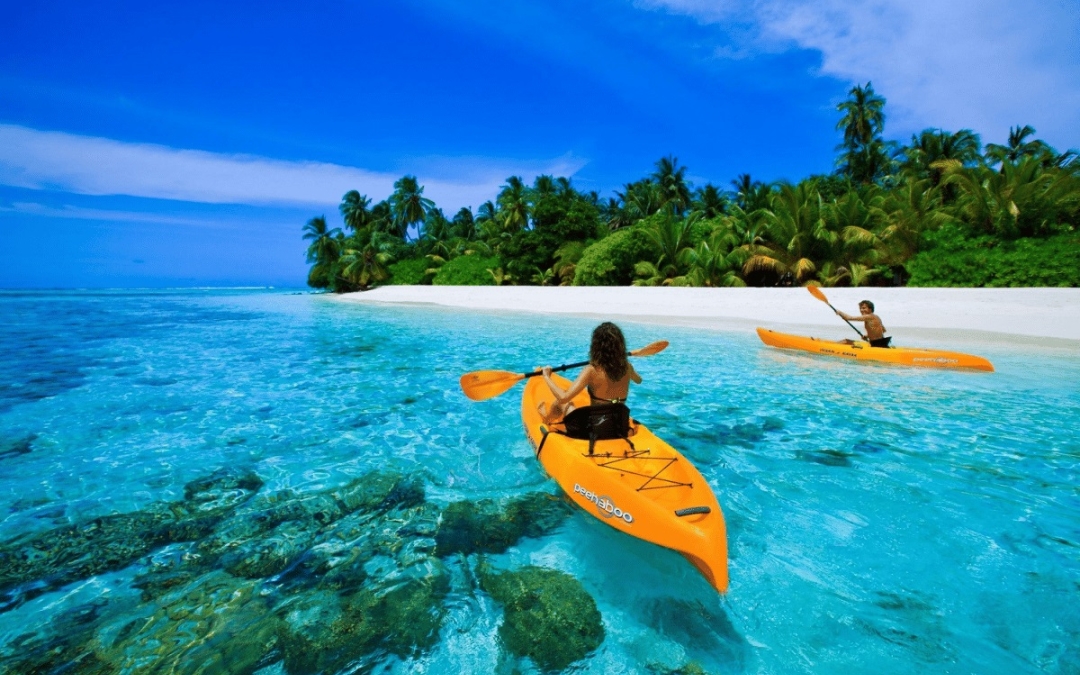
On Phu Quoc, sea lovers paddle to hidden beaches and reefs.
>> Read More: The Ultimate Phu Quoc Travel Guide – From Hidden Gems to Local Delights
Da Lat – Tuyen Lam Lake (Lam Dong Province)
Known for its cool highland climate, Da Lat offers a refreshing contrast with kayaking on Tuyen Lam Lake. Surrounded by pine forests and rolling hills, the lake is serene and ideal for slow, meditative paddling.
Many tours combine kayaking with trekking or picnics in forest clearings. Mornings are especially beautiful when mist lingers over the water. The calm conditions also make it perfect for beginners and families.
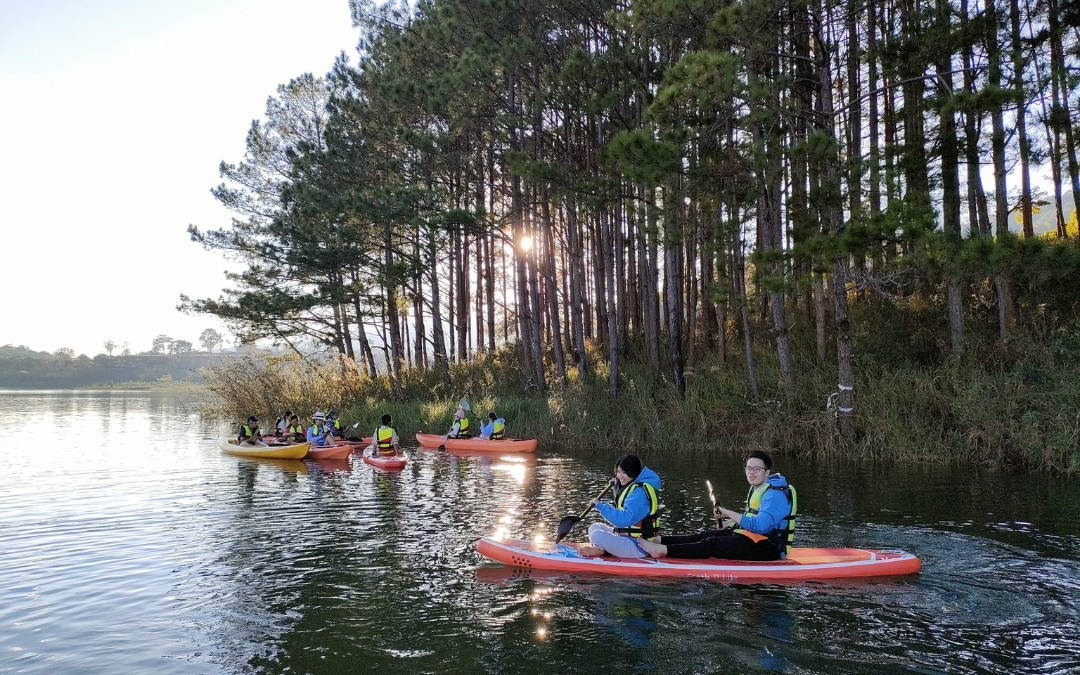
Tuyen Lam Lake in Da Lat mirrors pine hills in crisp air.
>> Read More: Top 17 Beautiful Places To Visit In Da Lat For A Dreamy Mountain Escape
Dau Tieng Lake (Tay Ninh Province)
One of Vietnam’s largest man-made lakes, Dau Tieng offers calm, expansive waters framed by Ba Den Mountain in the distance. While not as famous as other spots, its peaceful setting makes it excellent for camping and kayaking getaways.
Visitors often paddle at sunrise or sunset, when golden light reflects across the still surface, before returning to campsites for barbecues. Rentals are inexpensive, and the area remains largely untouched by mass tourism.
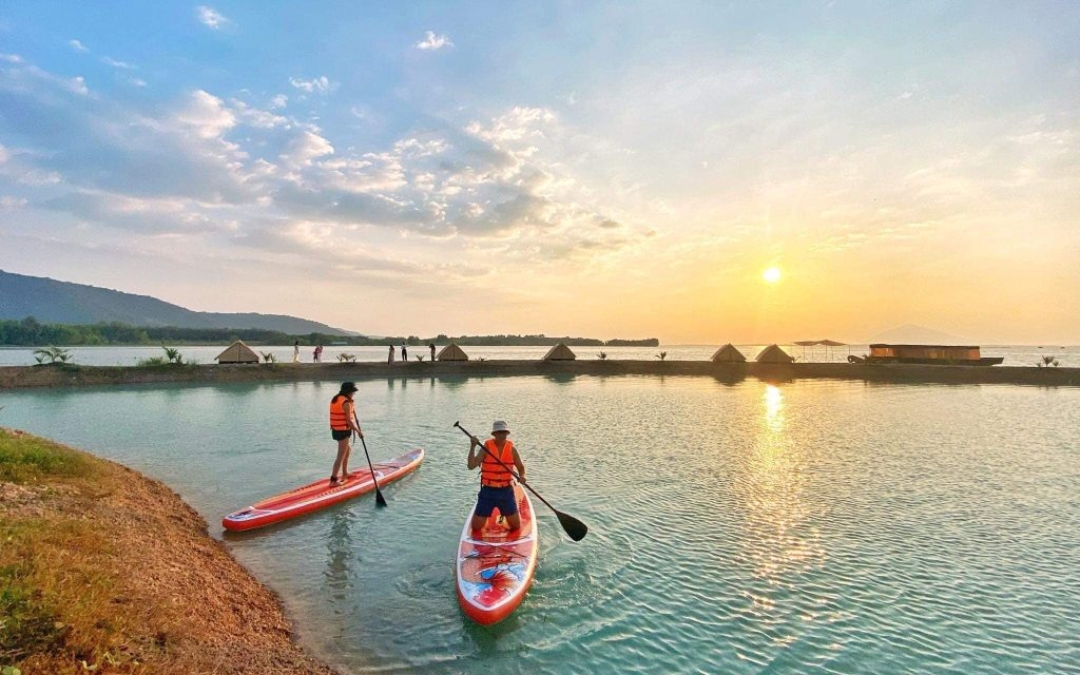
Dau Tieng Lake stretches wide, offering calm waters for beginners.
Cat Tien National Park (Lam Dong Province)
A paradise for eco-travelers, Cat Tien National Park combines tropical forest with rivers and wetlands. Kayakers can paddle along the Dong Nai River or Bau Sau (Crocodile Lake), surrounded by dense jungle alive with bird calls and monkeys.
Many eco-lodges offer sunrise kayaking tours, where the forest awakens with sound and light. This destination highlights biodiversity more than scenery, making it perfect for travelers who want adventure blended with wildlife encounters.
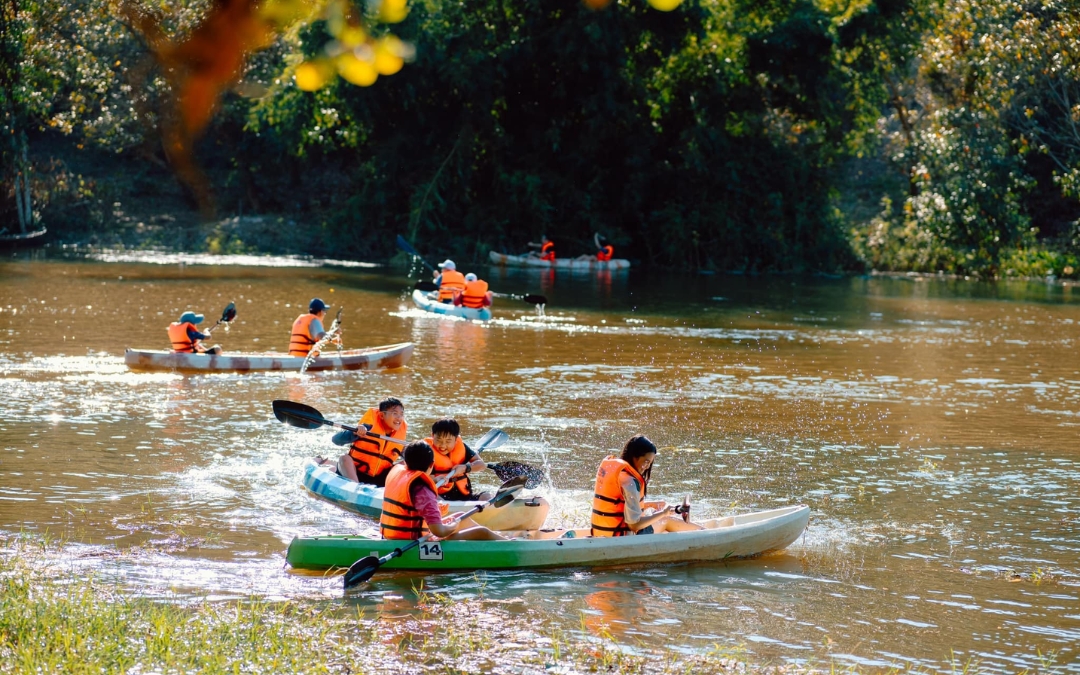
Cat Tien Park immerses paddlers in dense jungle and rare wildlife.
>> Read more: Top 13 Vietnam National Parks to Visit for Nature Lovers
Prices, Rentals, And Best Time To Kayak In Vietnam
Kayaking in Vietnam is one of the most affordable and enjoyable water activities for travelers. With low rental fees, flexible tour options, and diverse seasonal highlights, it’s accessible for all skill levels—from beginners to experienced paddlers.
Kayak Rental Costs in Vietnam
The cost of kayaking in Vietnam is generally budget-friendly. Prices vary depending on the location, type of service, and whether it’s part of a tour or a direct rental. On average, you can expect to pay from 40,000 VND to 150,000 VND (about $1.5–6.0) per person, with most short sessions falling under 100,000 VND ($3–4).
Guided tours or kayaking included in cruise packages may cost slightly more but usually come with extra services like equipment, safety support, and cultural stops.
Kayak Rentals and Guided Tours
Travelers can choose between standalone rentals or guided tours, depending on their preferences.
- Standalone rentals: In places like Cat Ba Island/Lan Ha Bay, kayaks can be rented directly, giving paddlers freedom to explore at their own pace. In Phu Quoc, rentals are available at beaches and riverside resorts.
- Guided tours: Many Halong Bay cruises (La Pinta, Heritage, Peony, Athena) include kayaking sessions of 45–60 minutes, complete with equipment and safety instructions. In Trang An (Ninh Binh) and Dalat’s Tuyen Lam Lake, kayaking is almost always part of a guided tour.
Best Time to Kayak in Vietnam
The best time to kayak in Vietnam depends on the region, but most travelers will find ideal conditions in spring (March–June) and autumn (October–December). During these months, the weather is mild, the skies are clear, and the seas and rivers remain calm.
No matter where you go, early morning and late afternoon are often considered the best times of the day, offering soft light, magical sunrises or sunsets, and quieter waterways away from peak tourist hours.
Vietnam Kayaking Safety And Local Tips for First Timers
To ensure a safe, enjoyable, and memorable trip, keep in mind these essential safety measures and local insights:
- Wear a life vest: Always fasten your vest properly, regardless of swimming ability.
- Warm up before paddling: Light stretches help prevent cramps.
- Follow instructions: Listen carefully to guides on routes, safety rules, and timing.
- Check the weather in advance: Avoid strong winds, storms, or heavy rain.
- Don’t paddle alone: Especially in remote areas, always join a group or guided tour.
- Stay clear of hazards: Keep a distance from cliffs, rocks, other boats, and cave entrances unless guided.
- Avoid alcohol: Never kayak while drinking.
- Balance carefully: Enter and exit slowly; avoid leaning too far to one side.
- Paddling technique basics: Grip the paddle shoulder-width, keep your wrists straight, dip the blade one-third deep, and alternate strokes evenly.
- What to bring: Water, sunscreen, hat, sunglasses, insect repellent, dry bag for electronics, swimsuit, comfortable shoes, personal medicine, and ID.
- Respect the environment: Never litter, protect marine and freshwater habitats.
- Choose the right kayak: Double kayaks are more stable and ideal for beginners.
- Be aware of jellyfish: Mild stings can occur in Ha Long Bay, but no dangerous predators are a concern in Vietnam’s waters.
Kayaking brings you closer to Vietnam’s soul—whether it’s drifting beneath limestone towers, exploring mystical caves, or paddling through floating villages alive with tradition. With countless rivers, bays, and lakes to explore, the memories you create will linger long after the journey ends.
If you’re ready to experience the magic of kayak in Vietnam, let Asia Pioneer Travel craft a personalized itinerary just for you. From hidden lagoons to cultural encounters, we design adventures that go beyond the ordinary. Start planning today, and let your paddle strokes uncover Vietnam’s most unforgettable waterscapes.
